Brian Windows keeps the honey bees buzzing
Liina Flynn
17 May 2020, 8:00 AM
 Brian Windows inspects his bee hives.
Brian Windows inspects his bee hives.Lismore beekeeper Brian Windows works in one of the oldest professions in the world - beekeeping. While modern bee keeping was invented in the 1700s, Brian has actually been keeping bee hives for 30 years. The man who was once a CSIRO scientist took up the hobby of beekeeping and has never looked back - he may, however look around to see if there are any bee swarms.
Brian is the secretary of the Northern Rivers branch of the Amateur Beekeepers’ Association and has see the club's membership grow massively in the ten years since he moved to Lismore and joined the club.
Brian took The Lismore App editor Liina Flynn on a tour of his backyard hives, so she could find out just what beekeeping was all about.
Read more about Brian, the bee club and the flow hive: The sweet hobby of bee keeping gains popularity
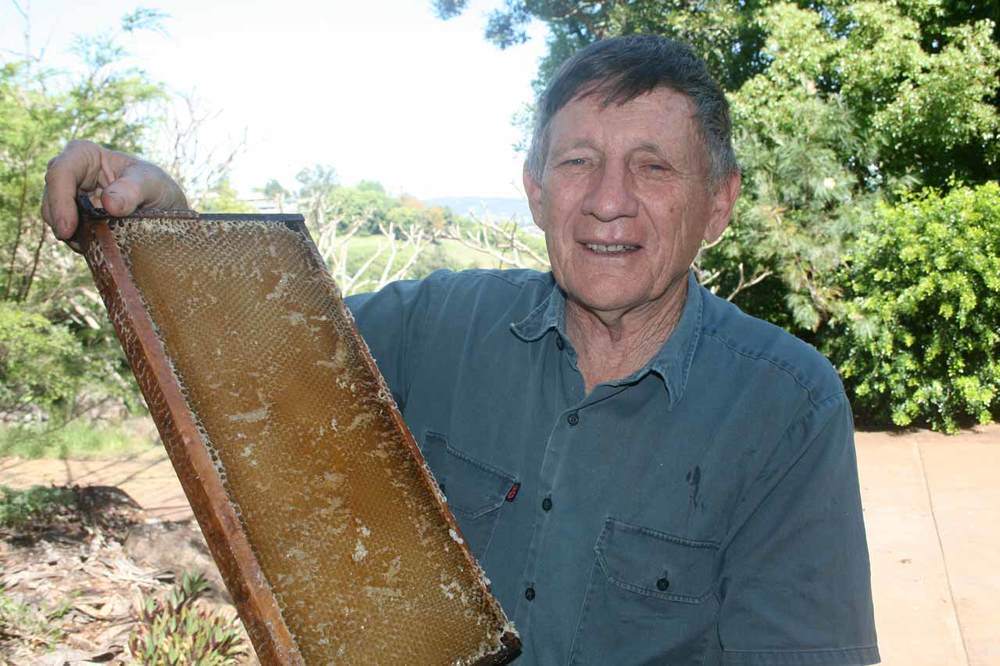
Brian Windows.
“Bees hate the colour black and they don’t like dark blue either… most bee keepers wear white,” Lismore beekeeper Brian Windows tells me as we get ready to go and look at his bee hives. I’m wearing a black singlet top and blue jeans.
Luckily I have a large white shirt with me that will hide the offending colours and hopefully avoid, according to Brian, “one of the most painful insect stings you can get”.
Onto my costume, we add a netted helmet and white gloves and we’re off down the hill to his hives.
The sun is shining, the sky is blue and there’s a gentle buzz in the air as hundreds of honeybees go in search of flowers to extract nectar and pollen from, pollinating flowers as they go.
The bees industriously carry the fruits of their labours back to their hives and make the sweet honey we humans so love to eat. It’s a perfect day for beekeeping.
Beekeeping is always done on warm days, because bees need to be warm to be able to fly.
They can’t fly in wet weather and stay in the hive in cold weather to eat their stored honey reserves. In winter, hives decline and bees have to shiver their bodies to generate enough heat to keep themselves alive.
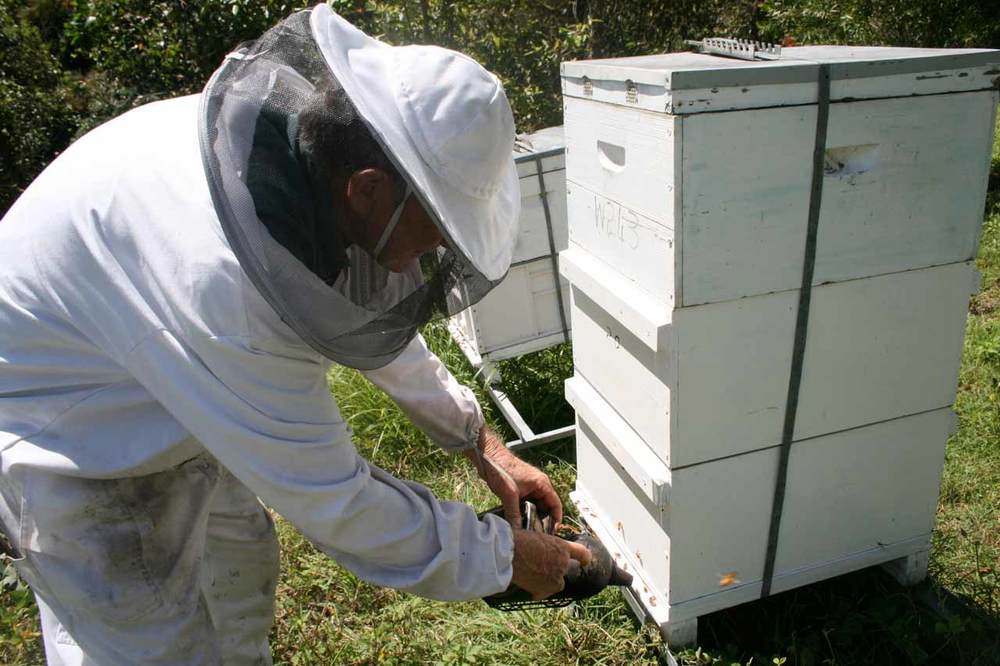
Smoking bees
Brian takes some tea-tree bark and sets fire to it, placing it in a small black can with an attached bellows.
He walks over to one of his hives and pumps some of the smoke into the small gap where the bees enter.
He says the smoke makes the bees think there is a bushfire and they all start gorging themselves on honey in preparation to take flight away from the hive.
It also makes them docile and means they won’t want to attack the beekeeper, for at least 10 minutes anyway.
“This was originally a swarm,” Brian says as he opens the lid on the top of the hive box.
At the entrance gap, you can see bees arriving with puffs of orange pollen gathered on their legs, carrying collected flower nectar in their mouths.
They store the nectar inside the cells of honeycomb and dry it out to create honey before capping the cell with a lid of wax.
“Honey is the energy food for bees and pollen is their vitamins,” Brian says.
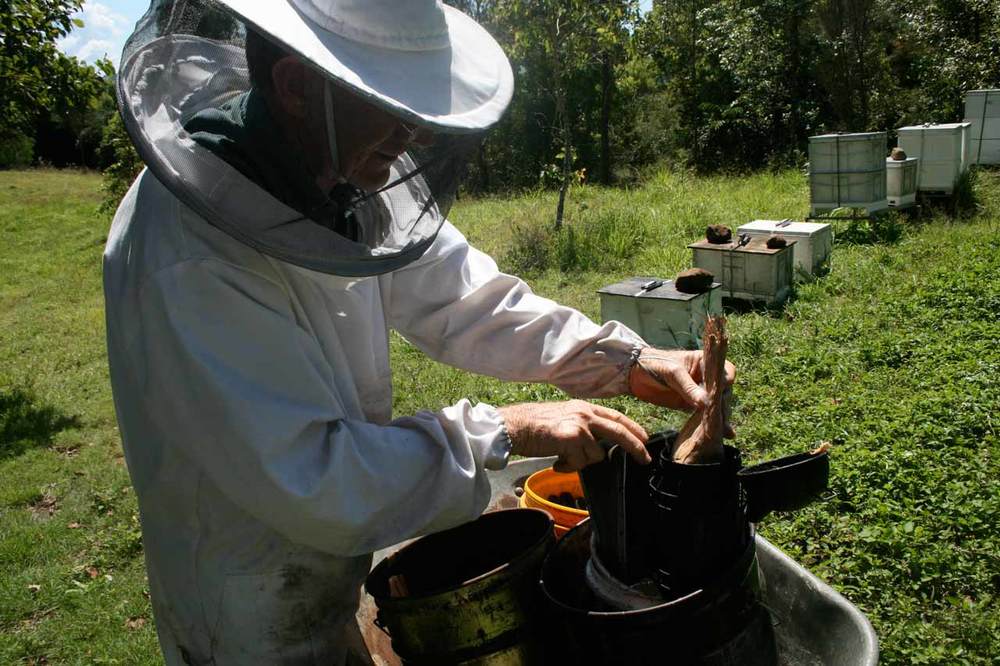
Pheromone communication
Brian tells me that bees communicate with each other by dancing and using pheromones.
When a bee returns to the hive and wants to tell the others where to find some tasty flower nectar, she will dance in a figure of eight pattern, with the axis of the eight pointing in the direction of the flowers, and the distance of the circles showing how far the bees need to fly.
I’m told to stand at the side of the hive because if I stand at the front, the bees will probably come out and chase me.
Brian believes their attack strategy is an ancient defence mechanism, possibly from having to defend their hives from bears.
He said bees will attack your head first then, if you don’t go away, they will attack your ankles.
Bees die when they sting you, so they aren’t doing it just for fun.
Most professional beekeepers wear gloves, but Brian isn’t wearing any today.
He is, however, wearing a full white body suit with a netted helmet.
Although he’s handling a honeycomb frame covered with hundreds of living bees, he doesn’t get stung once.
He claims that his bees are bred to be fairly docile and it must be true.
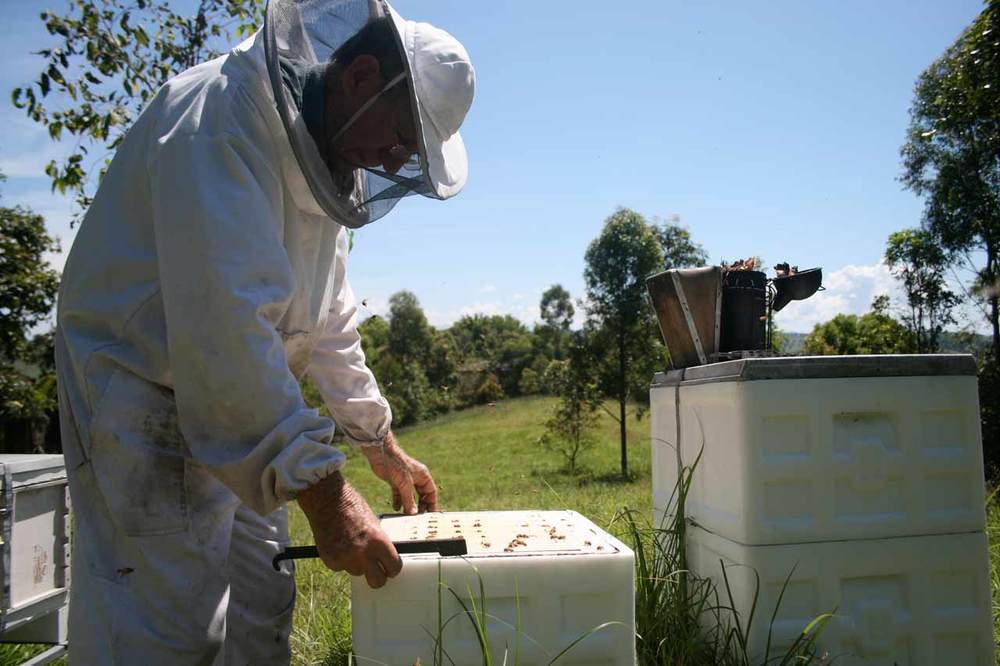
Amateur beekeepers
Brian started beekeeping as a hobby in 1990, when he lived in Sydney and worked as a CSIRO scientist.
After he and his wife moved up to the North Coast in 1995, he grew his hobby from only a couple of hives to 50 hives and he’s now the secretary of the Northern Rivers branch of the Amateur Beekeepers’ Association. As well as keeping hives at his home in Lismore Heights, he migrates his hives around to three different local sites, including one at Monaltrie.
He said the North Coast area has one of the highest percentages of beekeepers in Australia, especially since the flow hive was created - making keeping bees a lot easier and cheaper.
“It’s an interesting hobby and quite complicated,” Brian said.
“I thought ‘this is something I can do after I retire’ and it gets me out of the house. If you don’t count the labour of looking after them and extracting the honey, you can make a profit on it. You can get 100 kilos of honey from one hive in a year… most commercial beekeepers have 400 hives.”
He moves his hives around the area throughout the year to wherever the trees are in flower; at the moment he has most of them on a Macadamia farm.
Because of nature’s variability, some trees like the ironbark are unpredictable in their flowering and can’t be relied on as a food source for the bees.
Honey types
But macadamias have the advantage of predictably flowering every year and also have good pollen which helps to build up the strength of Brian’s hives.
Brian said ironbark honey was one of the most popular honeys on the North Coast, but that further west, much of the honey was produced from Patterson’s curse flowers.
Locally, a unique Australian honey made from jelly bush is produced near Woodburn and Brian said it was considered medicinal due to its ability to kill bacteria.
In fact, honey in general is considered good to put on wounds because it has natural peroxide in it.
Despite honey’s healing properties and sought-after sweetness, Brian said there are not many women in the local amateur beekeeping club, “because they don’t like getting stung”.
Apparently, beekeepers’ wives can even develop allergies after they have been stung a few times; the stings often happening when they wash the clothes of their beekeeping husbands.
“If you get a lot of light stings you could become allergic to the bee venom,” Brian said. “But if you have heavier doses, you can become more tolerant.”
A bee lands on the leg of my blue jeans, but Brian has warned me not to swat at a bee. They hate that.
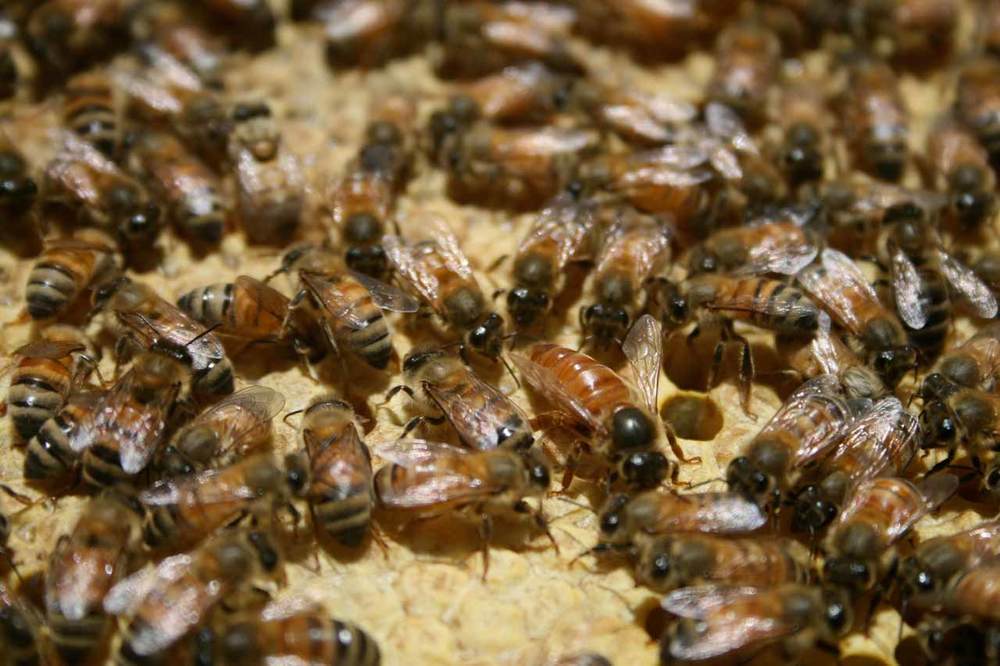
The queen bee is larger than the other bees.
Queen Bee
Brian pulls out a frame of honeycomb from the brood box and starts looking for a queen bee.
“There’s the queen,” he says, pointing to a large orange bee with a pointier bottom.
Every hive needs to have a queen bee to lay eggs, and she’s definitely bigger than the other bees.
There are bee eggs and larvae in some of the cells, and lots of worker bees moving around the queen.
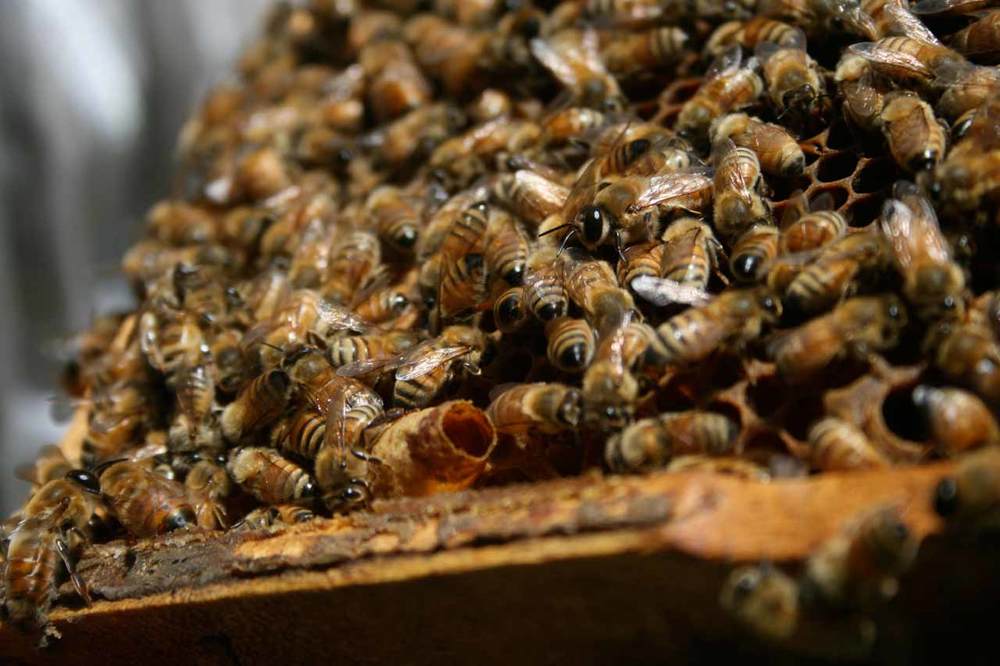
Bee society
Bees live in co-operative, communal society and there are similarities between bee and human societies.
Each bee citizen plays its own societal role from being worker bees, with tasks such as nursing, housekeeping or going out into the field, to the roles of drones and the hive queen.
Fertilised bee larvae destined to be queens are fed royal jelly by nurse bees.
It’s a bee food made from honey and pollen which makes the bees’ ovaries grow, turning them into queens. Unfertilised eggs turn into drones.
Brian said the drone’s only task is to mate with and fertilise the queen - after which, he dies. When mating, the queen takes to the air and mates with up to 50 drones on the wing - and gets five years worth of semen in one go.
And at the end of summer, drones gets booted out of the hive because they are unproductive and the hive keeps the food resources for the workers over winter.
A bee can live for six weeks, so it’s no wonder the queen has to constantly lay eggs.
“Worker bees don’t have much of an existence,” Brian said. “They work all day long and the queen lays eggs, but it is an efficient way to survive.”
Brian looks around and tells me we need to look around to check there are no bee swarms, because sometimes, that's what they do.
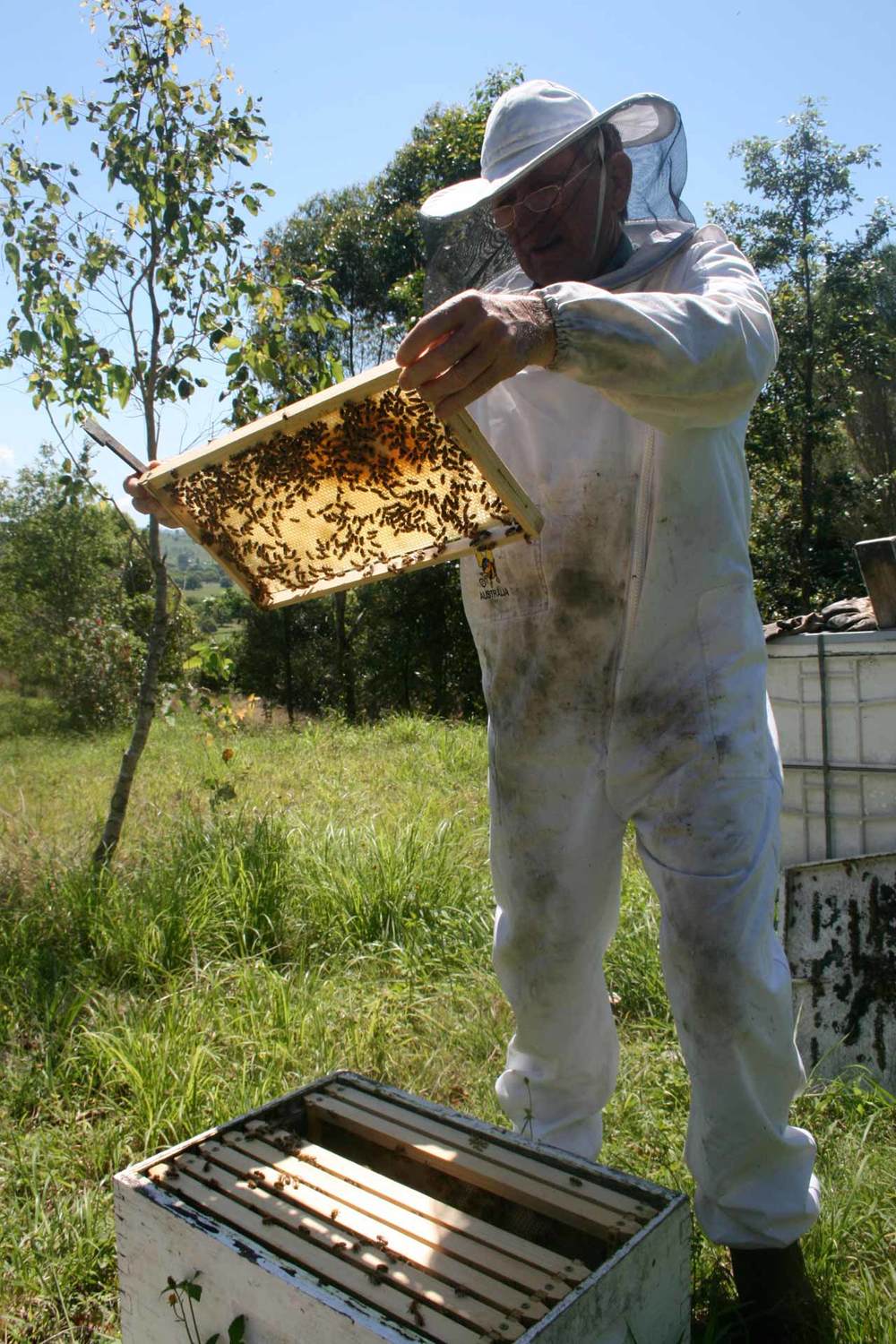
Swarming
He explains that bees swarm when the bee hive gets too crowded and half of the bees leave the hive with the queen bee to look for a new hive.
Before they fly off in a big group, they gorge themselves on honey to prepare themselves for the process of building a new wax honeycomb structure in the new hive.
It takes seven kilos of honey for a bee to produce one kilo of beeswax from the glands in their legs.
Bee swarms can be quite large considering there are up to 60,000 bees in a full production hive, but Brian says a good beekeeper’s job is to prevent the hive from swarming.

Hive beetles in a hive.
Hive beetles
Brian is checking another frame in the hive and he spots a little black beetle crawling around the honeycomb.
It’s one of the small hive beetles, a problematic and destructive beekeeping pest believed to have been introduced into Australia via fruit a few years ago.
Brian said the beetles’ larvae feed on protein, eating the bees’ larvae in the hive, eventually killing the hive if not managed with careful vigilance.
He lost six of his hives last year to beetle infestation and he now manages the pest with beetle traps placed under the floor of the hives, which catch and kill the beetles and their larvae.
There are many growing problems with diseases and pests that are affecting the beekeeping industry in Australia.
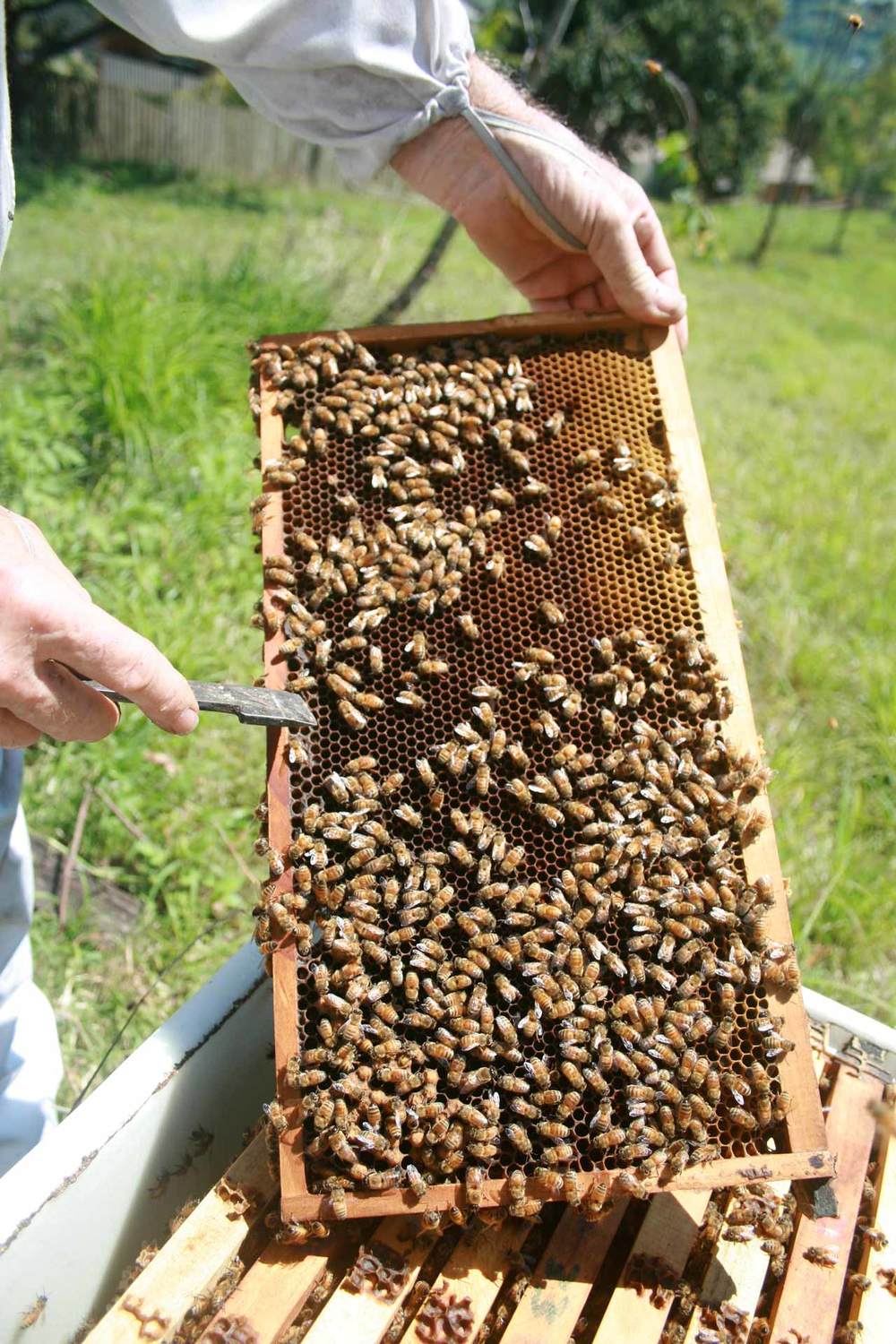
Bee decline
In fact, bee numbers have been declining worldwide over the last few years and in 2009, one third of the bee colonies in the US did not survive the winter due to a mysterious colony collapse disorder.
Some studies have shown that pesticides and chemicals may be detrimentally affecting bee physiology.
Brian said with the loss of many forest tree species on the North Coast due to logging and bell-miner dieback, there are now fewer areas where bees can gather suitable flower nectar for honey production.
He has also looked at a recent study into forest plantation types that shows the majority of plantation species are not appropriate for beekeeping.
With the decline in nectar-producing flowers and fewer younger people taking up the art of beekeeping, we can only hope that the future of the honey industry stays strong, or else we may not be able to keep enjoying a spoonful of honey in our tea.
Brian said there are a few younger people taking up the business, but more are always needed.
“It is a good occupation,” Brian said. “You need to be a good businessman, like being out in the bush and be ready to do heavy work sometimes.”
And no doubt, you will need to have no fear of being stung by bees.

Bee facts
Bees live for 6 weeks in summer.
In one day, a bee will fly up to 3 kilometres.
Honey contains less than 20% water content, which is why it doesn’t ferment.
Read more about Brian, the bee club and the flow hive: The sweet hobby of bee keeping gains popularity
JOBS